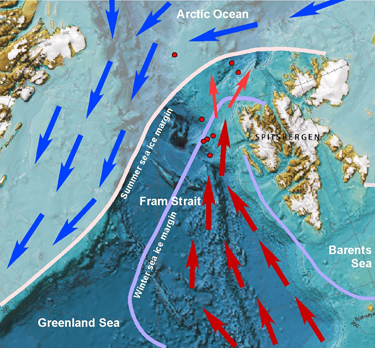|
Holocene variability in the Arctic gateway
Principal Investigators: Matthias Prange (University of Bremen), Robert Spielhagen (IFM-GEOMAR), Martin Frank (IFM-GEOMAR), Gerrit Lohmann (AWI Bremerhaven), Rüdiger Stein (AWI Bremerhaven)
Project Scientists:
Juliane Müller (AWI Bremerhaven),
Axel Wagner (AWI Bremerhaven), Kirstin Werner (IFM-GEOMAR)
Working area of the HOVAG project: In the eastern Fram Strait, relatively warm Atlantic Water enters the Arctic Ocean (red arrows), while a perennial ice cover and cold surface waters characterize the East Greenland Current (blue arrows). Red dots mark locations of sediment cores analyzed in this study.
The study aims at a high-resolution investigation of climatic developments in the last 10,000 years in the Fram Strait and the Arctic Ocean – an area presently responding rapidly to global warming. Long sediment cores from the West Spitsbergen continental margin and the adjacent Yermak Plateau are analyzed in centennial to decadal resolution to determine the natural variability of the Atlantic Water inflow to the Arctic Ocean, the position of the sea ice margin, and the structure of the water column. Several sedimentological, micropaleontological, and geochemical proxy data sets from AMS-14C-dated long sediment cores are established, in close cooperation with partners in Norway, Spain, the UK, and Canada. Using a global climate model, a regional ocean-sea ice model, and results from the paleoceanographic investigations, the influence of variable boundary conditions on the hydrographic structure and ice cover of the Arctic Ocean, the atmospheric transport of heat and moisture, and the freshwater runoff into the Arctic is studied for climatically different time periods. Sensitivity studies will be performed to improve our understanding of the role of past, present and future Arctic oceanographic and climatic variability as well as teleconnections with other ocean basins.
A high-resolution stratigraphy of the analyzed long sediment cores (Fig. 1) will be established by AMS-14C and 210Pb measurements. Core logging (MSCL, color scanning) is obligatory. Sedimentological and micropaleontological work regards grain size determinations, the content of planktic and benthic foraminifers, and the analysis of planktic foraminiferal associations. Oxygen and carbon isotopic compositions of planktic and benthic foraminifers (by massspectrometry), as well as ratios of Nd and Pb isotopes (by MC-ICPMS) will be determined.
Organic geochemical work includes analyses of total organic carbon (TOC) and total nitrogen (TN) by LECO technique, C/N ratios, the hydrogen index (HI) and oxygen index (OI) values by Rock-Eval, and stable carbon isotopes of the bulk organic matter. Additionally, marine organic carbon concentrations and biomarkers (e.g., highly branched isoprenoids (HBIs) and brassicasterol both synthesized by diatoms) as basic parameters will be determined. For a more detailed classification of the organic carbon fractions, gas chromatography (GC), gas chromatography/mass spectrometry (GC/MS) and isotope ratio monitoring, and gaschromatography/mass spectrometry (Irm-GC/MS) techniques as well as compound-specific carbon isotope measurements of selected samples will be performed.
Modeling studies involve the regional ocean-sea ice model NAOSIM on a rotated model grid (to avoid the North Pole singularity). It is forced by atmospheric fields (including 2-m air and dew-point temperatures, wind speed and stress, precipitation rate, surface downward longwave and shortwave radiation) and continental river runoff. Forcing fields for the regional ocean-sea ice model NAOSIM will be derived from a transient Holocene run of the coupled global climate model ECHO-G.
Archives
Sediment cores for studies within HOVAG were obtained by RV "Maria S. Merian" during leg MSM05/5b in August 2007. Older cores from several RV "Polarstern cruises" to the Yermak Plateau are also available.
|
| < Prev | Next > |
|---|


